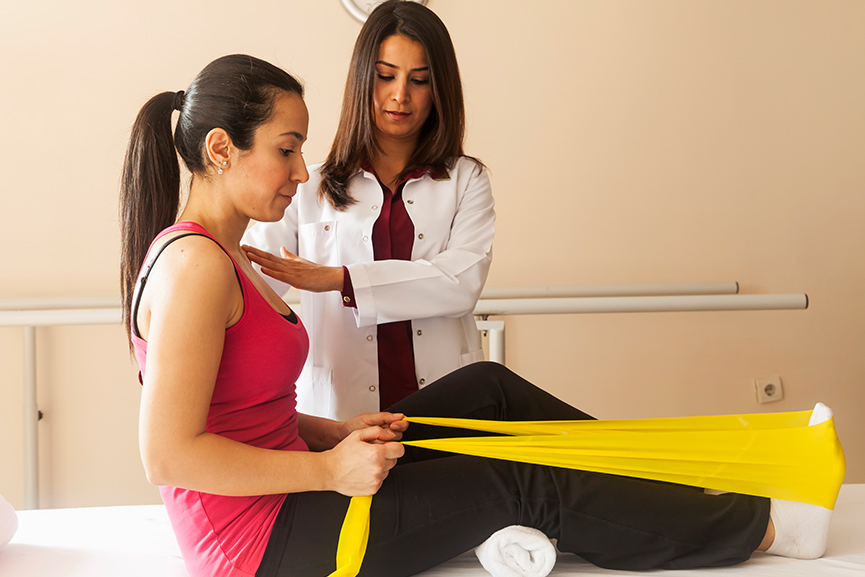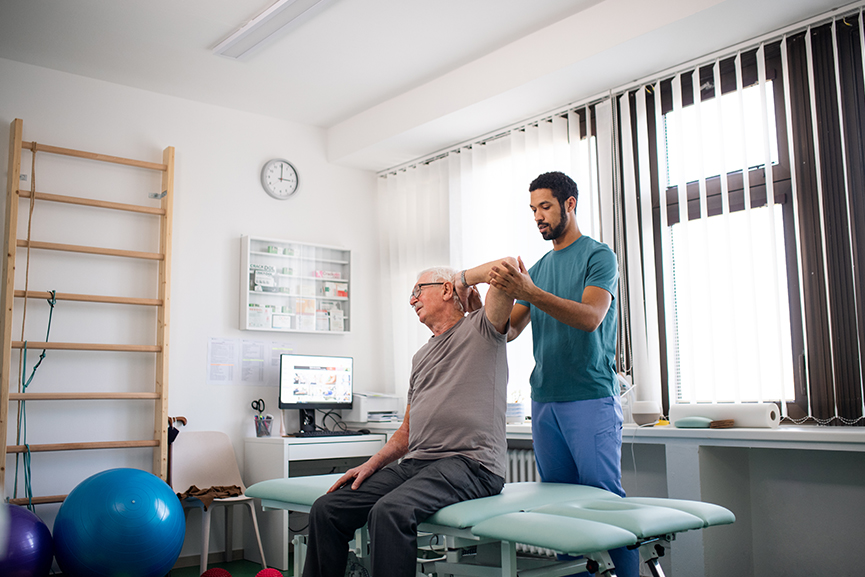Healthpointe Physical THerapy
Exercise

State of the Art Rehabilitative Equipment and Services:
<brManual Therapy
Exercise
Exercise is an integral part of physical therapy, as it helps to improve mobility, strength, and flexibility. Physical therapists use various types of exercises, such as stretching, resistance training, and aerobic conditioning, to address different conditions and injuries. These exercises are tailored to the individual needs and abilities of each patient, taking into account their specific goals and limitations. Through regular exercise under the guidance of a physical therapist, patients can regain function, reduce pain, and improve their overall quality of life.
The following is a list of exercise options offered at Healthpointe Physical Therapy.
Prescriptive Exercises
Prescriptive exercises are a crucial component of physical therapy. These exercises are designed to help patients recover from injuries, improve their range of motion, and strengthen their muscles. Healthpointe physical therapists use their expertise to evaluate each patient’s needs and develop a personalized exercise program that is tailored to their specific condition and goals.
Prescriptive exercises can include stretching, aerobic activity, resistance training, and balance training, among others. These exercises can be performed at home or in a clinical setting and are an important part of the rehabilitation process. By following a personalized exercise program, patients can improve their physical function, reduce pain, and ultimately achieve a better quality of life.

Sports Strengthening and Conditioning
Sports strengthening and conditioning is an essential component of physical therapy for athletes who are recovering from injuries or looking to prevent them. This type of therapy focuses on developing strength, flexibility, and endurance, as well as improving coordination and balance. A physical therapist will create a personalized plan that includes exercises and techniques to help athletes regain function and prevent further injury.
The goal is to improve overall athletic performance while reducing the risk of injury. With the guidance of a skilled physical therapist, athletes can safely and effectively achieve their fitness goals and return to their sport at full capacity.
Manual Stretching
Manual stretching is a commonly used technique in physical therapy for increasing flexibility and range of motion in tight or stiff muscles. It involves the use of hands or tools to apply gentle force to a muscle or group of muscles, with the goal of lengthening the tissues and reducing tension.
Manual stretching can be performed passively, where the therapist moves the patient’s limb or body part into a stretched position, or actively, where the patient performs the stretch themselves with guidance from the therapist. The technique is often used in combination with other physical therapy interventions, such as exercise and massage, to help improve function and reduce pain in individuals with musculoskeletal injuries or conditions.
Core Strengthening
Core strengthening is a crucial component of physical therapy for a variety of conditions, including low back pain, postural dysfunction, and sports injuries. The core muscles, which include the abdominals, back muscles, and hip muscles, work together to provide stability and support for the spine and pelvis during movement.
Our Healthpointe physical therapists use a variety of exercises to target these muscles, such as planks, bridges, and bird dogs, with the goal of improving core strength, endurance, and control. By improving core strength, patients can experience improved balance, reduced pain, and enhanced performance in their daily activities or sports.

Spine Stabilization
Spine stabilization is a crucial aspect of physical therapy that involves strengthening the muscles and ligaments around the spine to support its structure and function. The spine is a complex system of bones, discs, muscles, and ligaments that work together to provide stability and mobility to the body. Our physical therapists use a variety of exercises and techniques to improve spine stabilization, including core strengthening exercises, postural correction, and manual therapy.
By improving spine stabilization, physical therapy can help reduce pain, improve flexibility, and prevent further injury to the spine. It is an important component of treatment for many conditions affecting the spine, including herniated discs, degenerative disc disease, and spinal stenosis.
McKenzie Exercises
McKenzie Exercises, also known as Mechanical Diagnosis and Therapy (MDT), are a type of physical therapy technique that is used to evaluate and treat musculoskeletal conditions such as back pain, neck pain, and other joint-related problems. This therapy is based on the belief that certain movements and positions can alleviate or worsen pain, and aims to empower patients to take control of their own recovery by teaching them specific exercises and stretches to help alleviate pain and improve mobility.
McKenzie Exercises have been widely used by physical therapists since the 1980s and have been found to be effective in reducing pain and improving function in patients with various musculoskeletal conditions. The exercises are tailored to the individual patient’s needs and goals, and may involve a combination of stretches, strengthening exercises, and postural modifications to improve overall health and wellbeing.
Powerplate Exercise
Powerplate exercise is a form of vibration therapy that is increasingly being used in physical therapy settings to aid in rehabilitation and improve overall physical function. Powerplate machines utilize high-frequency vibrations that are transmitted to the body through a platform, causing the muscles to contract and relax rapidly. This form of exercise has been found to increase muscle strength, improve flexibility and balance, reduce pain, and enhance blood flow and circulation.
Physical therapists often incorporate Powerplate exercises into treatment plans for patients with a range of conditions, including back pain, arthritis, and muscle injuries. With its many benefits and versatility, Powerplate exercise has become a popular tool for physical therapists seeking to help their patients achieve optimal physical health and function.
Balance and Vestibular Training
Balance and vestibular training are important components of physical therapy that focus on improving a patient’s ability to maintain their center of gravity, body alignment, and stability. The vestibular system is responsible for providing information to the brain about head and body movement, while balance refers to the ability to control the body’s position in space.
A physical therapist may use various techniques and exercises to address deficits in these areas, such as specific movements that challenge the vestibular system, balance training exercises on unstable surfaces, and coordination and strengthening exercises to improve overall stability. These interventions can help patients regain confidence in their ability to perform daily activities, reduce the risk of falls, and improve their overall quality of life.

Gait Training
Gait training is a crucial aspect of physical therapy that involves helping patients regain their ability to walk safely and efficiently. The goal of gait training is to improve a patient’s walking pattern, posture, balance, and overall mobility. This type of therapy is often used for patients who have experienced a stroke, spinal cord injury, or other conditions that affect their ability to walk. The training process typically involves exercises that focus on strengthening the muscles and improving the range of motion in the legs and hips.
Additionally, physical therapists may use assistive devices such as walkers or canes to help patients achieve a stable gait. Ultimately, successful gait training can improve a patient’s quality of life by enabling them to move more easily and independently.
Work Conditioning
Work conditioning is a specialized program that is designed to help individuals recover from work-related injuries or illnesses and return to their previous level of physical function. It is a type of physical therapy that focuses on rehabilitating the injured worker and helping them build endurance, strength, flexibility, and range of motion. The program typically involves a combination of exercise, manual therapy, and functional activities that simulate work-related tasks.
Work conditioning is designed to be a progressive program that gradually increases in intensity and duration as the individual becomes stronger and more functional. The ultimate goal of work conditioning is to help the injured worker return to their job safely and with confidence, while minimizing the risk of re-injury.
Upper and Lower Extremity Exercises
Physical therapy often involves exercises aimed at improving upper and lower extremity function. Upper extremity exercises typically focus on strengthening the muscles of the shoulders, arms, and hands, as well as improving range of motion and coordination. These exercises may include resistance training with weights or bands, stretching, and functional movements such as reaching and grasping.

